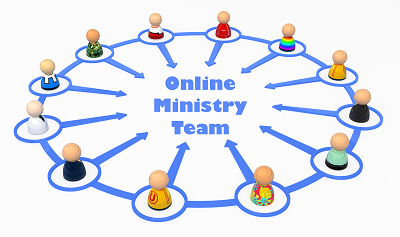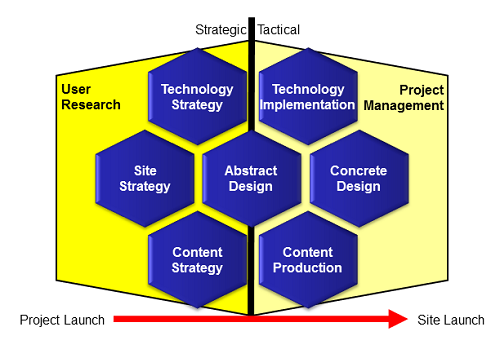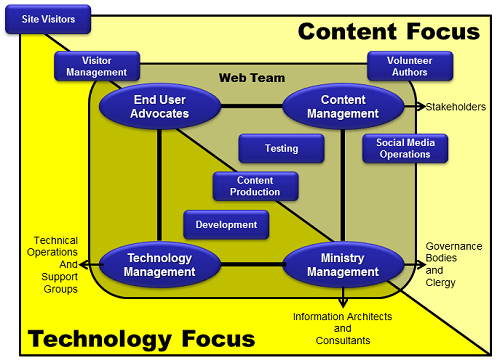Public Sample of the
Online Ministries Community Blog
|
Apr 24 |
The Team Role In Online Ministry Projects |
Posted by Bill Anderton
For the last week, I have been writing this series of blog postings that builds upon an earlier three-part series titled, “Beware of Geeks Bearing Gifts.” In the current series, I am writing about how online projects can be set up and managed in order to illustrate to beginners a few well-established best practices that remove risk for online projects and help insure that online projects meet the expectations of heir sponsoring churches and ministries.
 One critical component of my posting of April 22, “Common Characteristics of Successful Online Ministries” was the role of the “Team,” the people who develop and operate the church’s website, Internet presence or online ministry. Today, I am going to expand on my writing of about the Team.
One critical component of my posting of April 22, “Common Characteristics of Successful Online Ministries” was the role of the “Team,” the people who develop and operate the church’s website, Internet presence or online ministry. Today, I am going to expand on my writing of about the Team.
This will be the last of this particular series but I will return to this subject often in the future.
Online projects need resources and one of the most important are the people who do the work required. You need a group of people to not only plan and execute your project to the point of launching it but also, importantly, to perform the on-going operations, management and governance of your website after your “build” phase is over. In my previous blog postings, I have called this group the “Team.”
Your Team will span three broad areas:
Governance - Depending on your polity, governance is typically provided by your Board of Directors (if congregational polity) or another governing body within your church that establishes policies, authorities and provides resources for the project. Governing bodies typically do not provide management of the project itself but will provide proper oversight by setting policies and accountabilities. While not involved in the day-to-day operations of Internet projects, I always count governing bodies as part of the Team because of their important role. Also, in their lines of accountability, it is typical that governing bodies receive ongoing reports from the Team, review its overall performance and set/review goals of the project. Governance bodies are usually separate from the rest of the Team in as much as they provide oversight.
Leadership – Team leadership provides the day-to-day management of both the project and the Team. Leadership typically includes both clergy and laity leaders who will recruit, train and manage the remainder of the Team. Leadership is typically the most knowledgeable people on the Team in their respective roles. Typically, leadership may also be part of the labor force (below) thus doing much more than just providing management.
Labor force – The labor force includes the people who will have some hands-on role in the project in some development role (designers, coders, etc.) and operations (content authors, editors, photographers, etc.) The labor force can be composed of multiple specialists or generalists. The labor force is the people who actually do the work on the project.
Team members can include volunteers as well as any outside professionals you may engage to assist your church. Both volunteers and professionals can server in any combination of leadership or labor-force roles. The governance portion of the Team is almost always composed of volunteers or clergy of the church.
Team members can wear multiple hats and fill more than one role; indeed, they often do. It is possible that any single member of a Team might fill roles in all three areas.
Teams can be any size although care should be taken if Teams grow too large. Large teams can be a mixed blessing and they do require some care in their organization and management. Not counting governance bodies, Teams typically range in size from two to ten people.
Also, the Team might include work with casual contributors of content who might occasionally write an article or contribute calendar information. While they are valuable contributors to the online project, casual participants aren’t usually considered members of the Team because they do not typically work within the Team structure. Instead, they usually work on some sort of ad-hoc basis.
Teams can also be teams-of-one where one people solely does all of the work. However, this does introduce some long-term danger to the project because of the levels of long-term commitments that are needed. Building and operating websites, Internet presences or online ministries are lots of work! Also, these projects have to be operated over the long term; years and years. At some point, you are likely to suffer the loss of your team-of-one, for any number of reasons, and therefore all of your resources, in one action. This can be catastrophic.
Rather than teams-of-one, I much prefer to use small teams there the leader of the Team (the strongest member of the small Team) mentors and trains a couple of others; first to share the load (taking larger roles as their skills grow) and then to take over if needed.
In other words, teams-of-one MUST do succession planning, anticipating the time when the critical person has to step aside for any number of perfectly valid reasons.
It should also be mentioned that all teams, regardless of their size, should do succession planning. All Teams lose and gain members regularly. You should plan for these events to there is continuity of all of the Team’s efforts without the need to start over.
With an understanding of the roles of the Team, consider the organization of the Team. Team organization is typically dynamic, changing according to the phase that the project is in at the time.
The organization of teams typically takes three forms unique to the three broad phases of projects:
- The discernment and envisioning phase
- The development and build phase
- The operational phase
During the discernment and envisioning phase, Teams are typically very small, perhaps just one to three people. The make-up of the Team might consist of only one of the pastors of the church and perhaps a project champion and one other. For brand new projects, the Team members at this point are usually the seeds for expanding the Team in the next phase. However, I have been involved with churches where the whole governing body and important laity groups like Elders were also involved in discernment. Team members in this phase are typically generalists and may not even be technologists.
During the development and build phase, specialized Team members may join the Team for the sole purpose of providing specialized expertise appropriate for the nine classical steps of site planning, development and build-out (modeled on the Nine Pillars process shown below). The development and build phase begins after the discernment and envisioning phase and typically end soon after the site is launched.

For many comprehensive Internet presences or full online ministries that are built out on a series of stepping stones, development and build phase might operate more or less continuously in a sequential series of projects development cycles that grow the presence over a long period of time.
Once the site is launched, the project moves into its operational phase where the “content production” step of the Nine Pillars process becomes an ongoing daily or week effort. In this phase, Teams often morph into operational configurations that are specialized for this type of day-to-day operations and management of sites and their content inventory. Unless ongoing stepping-stone development cycles are used, the Team often sheds its development-only resources in this phase and gains new members in the form of content specialists.
In all three phases, my recommendation is to set up the structure shown in the diagram below (or use some other structure suitable for your church). I designed this structure to work within the typical environment of churches as well be compatible with the development framework that I typically recommend for churches (the Nine Pillars process shown in the diagram above.) This Team structure has been proven to work well in many situations.

This Team structure is composed of two broad foci:
- Technical focus – Those things that represent the technical resources of the project like servers, software, applications, page and CSS coding, browsers, etc.
- Content focus – Those things that represent the content resources of the project like text, pictures, graphics, design, layout, messages, etc.
Some of the roles are largely of a technical or content nature while others tend to be blends of both foci (as shown in the diagram.)
The four main functional roles of this make-up are:
Content Managers – Content managers are typically non-technical members of the Team who specialize in the creation and production of content. The role of this part of the Team would be to manage all of the content that needs to go into the website or other Internet assets like social media. This group should be the conduit for anyone in the church that has third-party-generated content to share. This group also creates original content as needed. I believe that the Editorial Department functions should reside within this group. See my blog of April 10, "Organizing the Management of Online Ministries" and April 11, "Minimal Editorial Skills Needed For A Church Webmaster To Thrive" for more details. Typically, the webmaster comes from this group since content and its editorial process are so closely associated with this role. Content Managers typically operate the content management system (CMS) set up and supported by the Technology Managers.
Technology Managers – Technical managers are typically members of the Team who are technicians, engineers and technology-oriented volunteers who oversee the technical development, installation, technical operations, support and technical aspects of the website. The responsibility of the server infrastructure (hardware, system software and application software) resides within this group. Also, as my blog posting of April 10, "Organizing the Management of Online Ministries" cited, the Production Department functions would reside within this group to take raw content (provided by the editorial processes) and provide any needed coding or production services to turn the raw content into web pages. The Technology Managers typically set up some form of content production and management system, either manual processes or an automated processes like a content management system (CMS). If the site or Internet presence is to be of any size, it is almost always managed by a server-based CMS that Technology Managers provide and support.
End User Advocate – This group provides a hugely important role in the success of the online ministry because they are the voice of all end users; end-user visitors to the site as well as any content authors or administrative people who must interact with the site and its technology. This is an ombudsman representing the interests of all users. If something is too complicated to use or the planned or published content isn’t telling the full story of the church in the right way, it is the duty of this group to speak up and advocate on behalf of the under-served constituency. It is the duty of this role to sets off alarms when the forest can’t be seen because of all of the trees in the way. This role doesn’t have to be fulfilled by someone with a technical background; it fact, it is better is the people in this group are not technologists (just like most of your visitors won’t be technologists either.) Often, I suggest that clergy or elders for this role.
Ministry Managers – Labeled as "Ministry Management" in my diagram, the standard industry term for this role is "Program Managers." Ministry Management doesn't have to be clergy but, instead, are the people who manage the online ministry. This group performs a big role in both the strategic and tactical planning of the site and seeing to the adherence to the development framework. This role often provides the “adult supervision” for the entire Team. The Publisher role should reside in this group as outlined in my blog of April 10, "Organizing the Management of Online Ministries." While the industry term for this role is “Program Manager,” that does NOT imply any role in technical “programming” as in the development or coding of software. Instead, the term “program” is used in its other meaning as a “system of services, opportunities, or projects; usually designed to meet a need” Program Managers usually handle the jobs of the “recording secretary” of the planning process (and often the strategic planning leader), project management and budget control. Program Managers are typically generalists and people with lots of common sense, "people persons" and often have business backgrounds rather than technical ones. They do need to be systems thinkers and be able to understand, even if nobody else on the Team does, all of the moving parts of the online ministry venture and keeps everything running smoothly.
These four major roles are designed to provide checks and balances for each other. Usually, if it is made clear up front the duties and responsibilities of these roles, harmony among the Team comes about rather quickly; peace will soon break out. If it doesn’t, it is the role of the Program Manager (in the Publisher role) to resolve any conflicts among the group.
During the development and build phase, certain phase-specific functions are carried out by all members of the Team:
- Development
- Testing
While professionals may be engaged in the development functions, it is always a good idea that testing be performed by all Team members in order to not only test the systems and content but also to become familiar with the operation of the resulting site. The End User Advocates should be deeply involved in the testing functions and provide important feedback from their perspective as the Team’s ombudsmen.
As noted above, after launching the site, the Team might possibly shed its development-specific resources and re-configure itself for its ongoing operations functions:
- Content management
- Forms management
- Calendar management
- Contact management
- E-campaign management
- E-commerce management
- Ads (or other dynamic content) management
- Social media operations and management
- Visitor report management
Note that I designed this Team structure so it works even when certain roles of the Team are out-sourced to professional assistance. Most common, the Technical Management role might be farmed out for professional help. I have also formed teams where the Program Management was also performed by outside professional help.
I have also seen situations where the entire Team was out-sourced but these situations are usually reserved for very-large or asset-rich churches that have a high commitment to online ministry. On rare occasions, I’ve helped small churches to out-source everything too but it is fairly rare due to the costs to these functions well.
However, a common configuration among churches of all sizes is to out-source three of the roles but retain some or most of the editorial functions of Content Management within the church. These roles are drawn from the ranks of church staff and volunteers. Keeping all or some of the important Content Management functions in the church can save a lot of money even when the other three roles are out-sourced to professional talent.
Professionals or volunteers, the Team organization remains the same as does proper strategic and tactical planning in a proper development framework.
Finally, I have a special note about online ministries. If your project involves elevating itself to being a full online ministry, your Team needs, ... well ..., people to do ministry!
Above, I have discussed classical operational roles and functions. For online ministries you will also need people to minister to people, engage in dialogs and responses and perform other ministry functions. The classical operational roles tend to serve as the facilitators and support staff for the ministerial roles.
Ministerial roles might be filled by clergy or by laity. Often, the ministerial roles are multi-faceted with laity doing certain function while clergy does others.
Category: (04-13) April 2013 Tag:
This is only the blog's abstract. To read the full text and participate in all of the interactive features of the community, please register. It's FREE!
Click Here To Register Into This FREE Community
